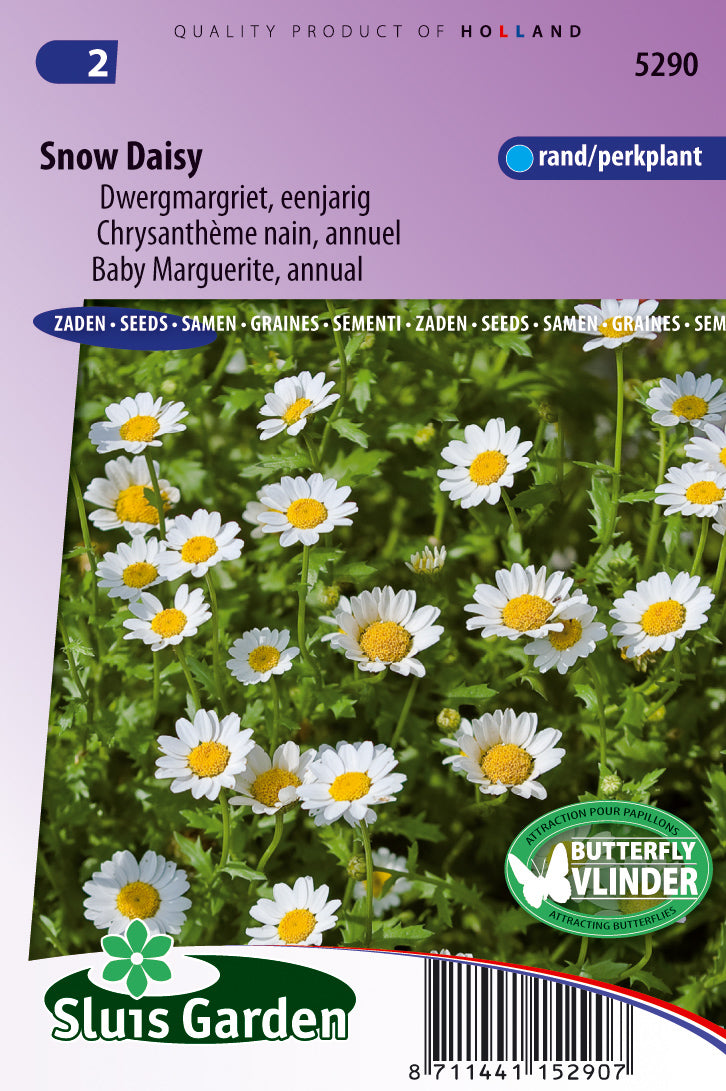1
/
of
1
Chrysanthemum paludosum Snow Daisy
Chrysanthemum paludosum Snow Daisy
Regular price
1.350 KWD
Regular price
Sale price
1.350 KWD
Unit price
/
per
Shipping calculated at checkout.
Couldn't load pickup availability
Chrysanthemum paludosum, commonly known as Snow Daisy, is a compact and low-growing perennial plant that produces small, daisy-like flowers with white petals and a yellow center. Here's a guide on how to grow Chrysanthemum paludosum Snow Daisy:
**1. Sunlight:**
- Plant Snow Daisy in a location that receives full to partial sunlight. These plants generally prefer a sunny spot for optimal blooming.
**2. Soil:**
- Choose well-draining soil with a slightly acidic to neutral pH. Good drainage is essential to prevent waterlogged conditions, which can lead to root rot.
**3. Planting:**
- Plant Snow Daisy in the spring or fall. Space the plants about 12 to 18 inches apart. Dig a hole slightly larger than the root ball, place the plant in the hole, and backfill with soil.
**4. Watering:**
- Keep the soil consistently moist, especially during the plant's establishment period. Once established, Snow Daisy is somewhat drought-tolerant, but regular watering during dry spells is beneficial.
**5. Mulching:**
- Apply a layer of organic mulch around the plants to help retain soil moisture, suppress weeds, and regulate soil temperature.
**6. Fertilization:**
- Use a balanced, all-purpose fertilizer in the spring to promote healthy growth and blooming. Follow the package instructions for application rates.
**7. Deadheading:**
- Deadhead spent flowers regularly to encourage continuous blooming and maintain a tidy appearance.
**8. Pruning:**
- Trim back the plants after the first flush of blooms to encourage a bushier habit and potentially promote additional blooming.
**9. Winter Care:**
- In regions with cold winters, provide a layer of mulch around the plants to protect them from frost. Snow Daisy is generally hardy, but the mulch helps insulate the roots.
**10. Pest and Disease Control:**
- Keep an eye out for common pests like aphids or spider mites. Treat any infestations promptly. Snow Daisy is relatively resistant to diseases.
**11. Propagation:**
- Propagate Snow Daisy through division in the spring or fall. Dig up the plant, divide the root ball into smaller sections, and replant them.
**12. Companion Planting:**
- Snow Daisy can be planted alongside other sun-loving perennials and annuals to create a colorful and vibrant garden bed.
**13. Organic Certification:**
- If you wish to grow Snow Daisy organically, use organic soil amendments and fertilizers. Follow the guidelines and requirements set by your local organic certification body.
By following these general guidelines, you can grow Chrysanthemum paludosum Snow Daisy and enjoy its charming white blooms in your garden. Keep in mind that specific growing conditions may vary based on your local climate and soil characteristics.
**1. Sunlight:**
- Plant Snow Daisy in a location that receives full to partial sunlight. These plants generally prefer a sunny spot for optimal blooming.
**2. Soil:**
- Choose well-draining soil with a slightly acidic to neutral pH. Good drainage is essential to prevent waterlogged conditions, which can lead to root rot.
**3. Planting:**
- Plant Snow Daisy in the spring or fall. Space the plants about 12 to 18 inches apart. Dig a hole slightly larger than the root ball, place the plant in the hole, and backfill with soil.
**4. Watering:**
- Keep the soil consistently moist, especially during the plant's establishment period. Once established, Snow Daisy is somewhat drought-tolerant, but regular watering during dry spells is beneficial.
**5. Mulching:**
- Apply a layer of organic mulch around the plants to help retain soil moisture, suppress weeds, and regulate soil temperature.
**6. Fertilization:**
- Use a balanced, all-purpose fertilizer in the spring to promote healthy growth and blooming. Follow the package instructions for application rates.
**7. Deadheading:**
- Deadhead spent flowers regularly to encourage continuous blooming and maintain a tidy appearance.
**8. Pruning:**
- Trim back the plants after the first flush of blooms to encourage a bushier habit and potentially promote additional blooming.
**9. Winter Care:**
- In regions with cold winters, provide a layer of mulch around the plants to protect them from frost. Snow Daisy is generally hardy, but the mulch helps insulate the roots.
**10. Pest and Disease Control:**
- Keep an eye out for common pests like aphids or spider mites. Treat any infestations promptly. Snow Daisy is relatively resistant to diseases.
**11. Propagation:**
- Propagate Snow Daisy through division in the spring or fall. Dig up the plant, divide the root ball into smaller sections, and replant them.
**12. Companion Planting:**
- Snow Daisy can be planted alongside other sun-loving perennials and annuals to create a colorful and vibrant garden bed.
**13. Organic Certification:**
- If you wish to grow Snow Daisy organically, use organic soil amendments and fertilizers. Follow the guidelines and requirements set by your local organic certification body.
By following these general guidelines, you can grow Chrysanthemum paludosum Snow Daisy and enjoy its charming white blooms in your garden. Keep in mind that specific growing conditions may vary based on your local climate and soil characteristics.

